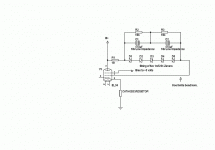Hi all,
I was doing a little cleaning up today and came across a article that I printed out a while back concerning an improved triode strap for tetrodes and pentodes. I drew up a diagram which I think is correct and I think I'm going to try it out. If anyone spots any mistakes please let me know. I will report back as to the results.
I was doing a little cleaning up today and came across a article that I printed out a while back concerning an improved triode strap for tetrodes and pentodes. I drew up a diagram which I think is correct and I think I'm going to try it out. If anyone spots any mistakes please let me know. I will report back as to the results.
Attachments
SY said:Is the motivation here a way to get around a limiting Vg2(max) spec?
The idea is to, and I quote, "to level- shift the screen to a lower DC level, thus limiting it's dissipation, and to bypass the level shifting circuitry with a low impedance ie. a *very* good, high value, low voltage cap of the BlackGate, Cerafine, Oscon variety.
It seems that I have posted this in the past. I had forgotten. Here is where I got the circuit:
http://ken-gilbert.com/techstuff/triode_connected_pentodesbts.html
and here is the thread from the last time I asked about it:
http://www.diyaudio.com/forums/showthread.php?s=&threadid=35091&highlight=triode+strap
http://ken-gilbert.com/techstuff/triode_connected_pentodesbts.html
and here is the thread from the last time I asked about it:
http://www.diyaudio.com/forums/showthread.php?s=&threadid=35091&highlight=triode+strap
Well, the capacitor will keep the string "alive" for short periods (depending on the dynamic resistance of the diodes). For long periods... well, do you know of any tube whose screen can draw negative current?
If nothing else, you can add a few ohms to the zeners to increase dynamic resistance. Then you have a simple ohmic circuit with an RC time constant. Oh, and keep in mind that the capacitor charges through the screen grid, so 220uF will charge slow as nuts as the tube heats up, giving it an extra incentive of high screen voltage as things settle.
Also, do you know of any EL34 which can draw appreciable plate current, with Vs = 0V and Vg < 0V (not drawing grid current)? Point being, you'll never get plate to zero because current drops well before screen reaches zero. Which happens faster than the plate, with the diodes in place. And if the plate were somehow forced below string voltage, the screen would go negative, drawing no current and
Tim
If nothing else, you can add a few ohms to the zeners to increase dynamic resistance. Then you have a simple ohmic circuit with an RC time constant. Oh, and keep in mind that the capacitor charges through the screen grid, so 220uF will charge slow as nuts as the tube heats up, giving it an extra incentive of high screen voltage as things settle.
Also, do you know of any EL34 which can draw appreciable plate current, with Vs = 0V and Vg < 0V (not drawing grid current)? Point being, you'll never get plate to zero because current drops well before screen reaches zero. Which happens faster than the plate, with the diodes in place. And if the plate were somehow forced below string voltage, the screen would go negative, drawing no current and
Tim
He did say "limiting it's dissipation". Not eliminating it. Let's use some good old fashioned logic here. It must work and give a measurable (and audible) difference when compared to using a simple resistor strap or there is no way Mr. Pearl would use it. It is not a cheap "trick" if you are going to use BlackGate caps. Rather than talk the idea to death I will sacrifice a pair of (awful) JJ EL34s and find out how effective the "trick" is. I guess I should turn the Zeners around huh? Although I was sure that I drew up the idea as he described it. Oh well.
Be interested in your listening results, and some measurements if you can do them, compared to the baseline series resistor.G said:Rather than talk the idea to death I will sacrifice a pair of (awful) JJ EL34s and find out how effective the "trick" is.
Triode Strapping
Hello ,
Also try G2 to anode via 100 ohm resistors , G3 to cathode and G2/G3 to anode via 100 ohm resistor . EL34 allows this as does EL822 and S11E12 , many beamies and pentodes already have the suppressor/beam plates tied internally to the cathode . A consequance of this is higher transconductance , but only slightly .
cheers
316a
G said:He did say "limiting it's dissipation". Not eliminating it. Let's use some good old fashioned logic here. It must work and give a measurable (and audible) difference when compared to using a simple resistor strap or there is no way Mr. Pearl would use it. It is not a cheap "trick" if you are going to use BlackGate caps. Rather than talk the idea to death I will sacrifice a pair of (awful) JJ EL34s and find out how effective the "trick" is. I guess I should turn the Zeners around huh? Although I was sure that I drew up the idea as he described it. Oh well.
Hello ,
Also try G2 to anode via 100 ohm resistors , G3 to cathode and G2/G3 to anode via 100 ohm resistor . EL34 allows this as does EL822 and S11E12 , many beamies and pentodes already have the suppressor/beam plates tied internally to the cathode . A consequance of this is higher transconductance , but only slightly .
cheers
316a
- Status
- This old topic is closed. If you want to reopen this topic, contact a moderator using the "Report Post" button.
- Home
- Amplifiers
- Tubes / Valves
- A better triode strap?
